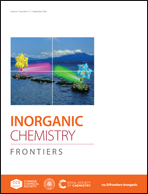Understanding the near-infrared fluorescence and field-induced single-molecule-magnetic properties of dinuclear and one-dimensional-chain ytterbium complexes based on 2-hydroxy-3-methoxybenzoic acid†
Abstract
The electronic [Xe]4f13 configurations of Yb(III) ions generate a variety of electronic energy levels, resulting in the fantastic optical and magnetic multifunctional properties of Yb(III) complexes. Here, 2-hydroxy-3-methoxy benzoic acid (H2MBA) was used to construct two dinuclear and one-dimensional Yb(III) complexes namely [Yb2(HMBA)2(MBA)2(DMF)2(H2O)2]·6H2O (1, DMF = N,N-dimethylformamide) and [NH4][Yb(HMBA)4] (2). Fluorescence measurements reveal that H2MBA can sensitize the characteristic near-infrared luminescence of Yb(III). Magnetic susceptibility measurements show that the two Yb(III) complexes are field-induced single-molecule magnets (SMMs) with anisotropy barriers of 18(1) cm−1 and 20(1) cm−1 for 1 and 2, respectively. The magnetism–luminescence–structure correlations as well as relaxation pathways are investigated by ab initio calculations and fluorescence spectrometry.



 Please wait while we load your content...
Please wait while we load your content...